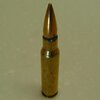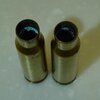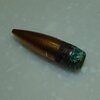The case came from Scharch, it was from pull down military surplus.
Interestingly enough, my bad cases... and there was 2 lots of 1000 cases, each bought at different times... came from Scharch. Since then, I have sworn completely off sourcing rifle brass from any other source than MY once-fired (or new...) brass. That does not set aside the potential for bad brass from any source, but it cuts it down a whole lot.
Besides the blown out case heads, these 2 lots of brass developed other problems...
Longitudinal cracks along the body (WCC brass)...

Neck splits (also WCC brass)...

...all that after only one firing.
Scharch, and very likely most other military brass that is not specifically sold as 'pull down' or components, was sourced from once-fired brass, fired by the military, and turned in for disposition. When I was in the Army in the '80's, that's where I worked... RXA, or Recoverable eXchange Activity, at Fort Carson. Anything that was user recoverable had to be turned into RXA for disposition... we are talking everything from torn tents, to tires, M60 tank engines... and, yes, brass. It was brought to us from the ammo point in 55gal drums, or whatever they had setting around...
See all that junk along the wall? That's recovered property waiting for me to take it to the civilians across the street for final disposition.

Some things, like tank engines, will be rebuilt. Most of that crap... and there are barrels up at the top of the ramp mixed in with the road wheels full of brass... will be sold as scrap at auction. This is the source for 'once-fired military' brass in most cases. Here's the kicker... brass is sold as scrap, NOT as spent brass cases, if you see the difference. It is NOT intended to be sold as reloading components... and it is not stored as such. Out in the elements, in possibly contaminated containers, wide open.
The other problem is what fired the brass... in the case of 7.62mm, my problem brass, it was most likely fired in a machine gun, which stretches cases by it's nature. Anyone can process this brass all they want, but the damage has already been done. Mix in poor storage, and possible contamination... and you have a recipe for disaster. 5.56mm brass is a little different, but it's stored the same way... see my point above.
There is also actual 'pull-down' components being sold as well... I bought some pulled Lake City 18 primed brass in 7.62mm a few years ago. The reason it was pulled brass was most likely because it failed some contract parameter, or it was rejected for other reasons. To recoup their losses, it is then sold, and resold to we reloaders. This brass in particular was spotted... not full-on corrosion spots, but enough where it would likely be rejected at final inspection, or at periodic inspection. At the end of the day, I wish I wouldn't have spent the money on this stuff, and just bought another case of Prvi loaded ammos and been done with it.

Loaded ammo is no guarantee, either... this is a case of LC16 7.62mm ammos I bought, in Federal packaging... It was so filthy I wondered if they didn't sweep it up off the floor. It, too, had spots, but not as bad as the pull-down cases I bought.
















